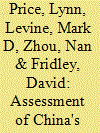| Srl | Item |
| 1 |
ID:
103348


|
|
|
|
|
| Publication |
2011.
|
| Summary/Abstract |
From 1980 to 2002, China experienced a 5% average annual reduction in energy consumption per unit of gross domestic product (GDP). With a dramatic reversal of this historic relationship, energy intensity increased 5% per year during 2002-2005. China's 11th Five Year Plan (FYP) set a target of reducing energy intensity by 20% by 2010. This paper assesses selected policies and programs that China has instituted to fulfill the national goal, finding that China made substantial progress and many of the energy-efficiency programs appear to be on track to meet - or in some cases exceed - their energy-saving targets. Most of the Ten Key Projects, the Top-1000 Program, and the Small Plant Closure Program will meet or surpass the 11th FYP savings goals. China's appliance standards and labeling program has become very robust. China has greatly enhanced its enforcement of new building energy standards but energy-efficiency programs for buildings retrofits, as well as the goal of adjusting China's economic structure, are failing. It is important to maintain and strengthen the existing energy-saving policies and programs that are successful while revising programs or adding new policy mechanisms to improve the programs that are not on track to achieve the stated goals.
|
|
|
|
|
|
|
|
|
|
|
|
|
|
|
|
| 2 |
ID:
099212


|
|
|
|
|
| Publication |
2010.
|
| Summary/Abstract |
This paper analyses the impact of an energy efficiency program for light vehicles in Brazil on emissions of carbon dioxide (CO2), the main greenhouse gas in the atmosphere. Several energy efficiency programs for light vehicles around the world are reviewed. The cases of Japan and Europe were selected for presentation here given their status as current and future world leaders in the control of passenger vehicle fuel consumption. The launching of the National Climate Change Plan and the pressure on the Brazilian car industry due to the world financial crisis make it a good time for the Brazilian government to implement such a program, and its various benefits are highlighted in this study. Three scenarios are established for Brazil covering the 2000-2030 period: the first with no efficiency goals, the second with the Japanese goals applied with a 10 years delay, and the third, with the Japanese goals applied with no delay. The consequences of a vehicular efficiency program and its middle and long-term effects on the consumption of energy and the CO2 emissions are quantified and discussed. The simulation results indicate that efficiency goals may make an important contribution to reducing vehicular emissions and fuel consumption in Brazil, compared to a baseline scenario.
|
|
|
|
|
|
|
|
|
|
|
|
|
|
|
|